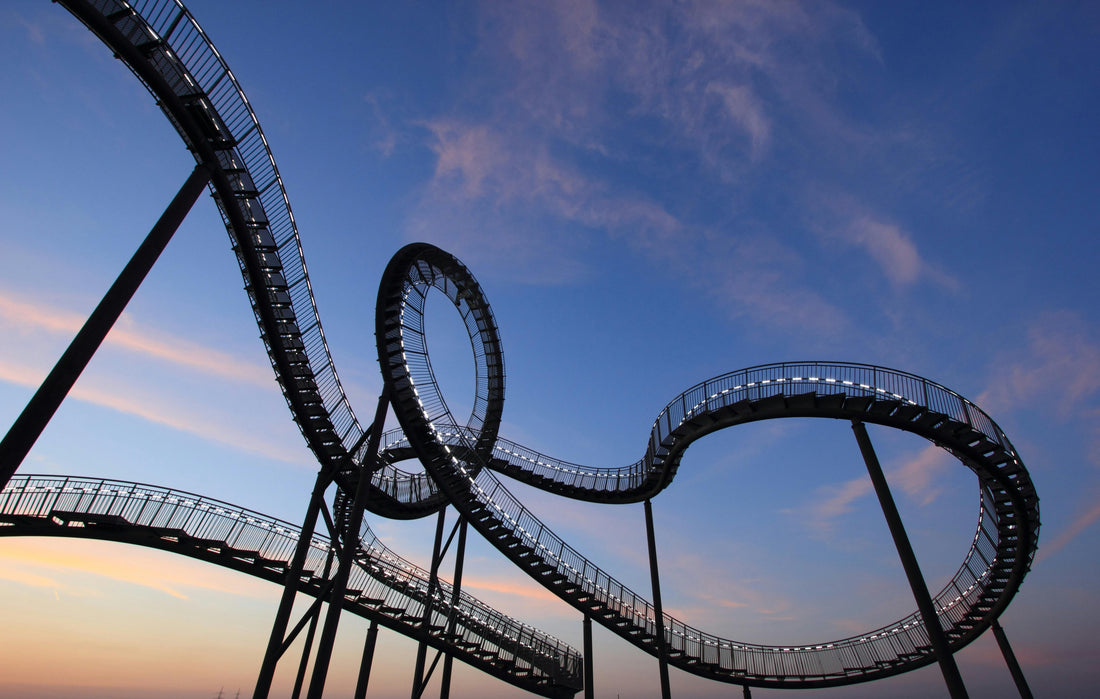For many, what can be learned from blood glucose curves and why CGMs are such a practical tool for changing habits initially sounds abstract. In this article, you'll learn the four most important curves , how they typically develop , and how you can tweak your habits to achieve optimal blood glucose responses. In the long term, your CGM will tell you almost in real time where you still need to fine-tune your habits and where you've already achieved a good tolerance. Be careful, blood glucose response can vary greatly from person to person. Nevertheless, general insights can be derived from the thousands of coaching sessions in our programs. You'll learn what these are in this post:
1. 👑Optimal blood sugar curve (“OPTIMUM”)

Blood sugar rises by a maximum of 30 mg/dl , reaches its peak within 60 minutes, and returns to its starting point within 90 minutes . There are no "dips."
When does it appear?
This ideal curve occurs when you eat a balanced meal with the right macronutrients (e.g. proteins, healthy fats, slow carbohydrates including fiber).
Health assessment
Perfect control . A curve like this shows that your body is able to process glucose efficiently. In the long term, this reduces the risk of insulin resistance and supports your hormonal balance.
⚒️How can you reach them?
A mix of fiber-rich carbohydrates, proteins, and fats should keep your blood sugar stable. Going for a walk after a meal can also help optimize your blood sugar levels. Give it a try; it's usually not a big deal, and a good blood sugar level can make cravings disappear for the rest of the day. So it's worth it!
💡Every metabolism reacts individually, here is an illustrative example of which meal can correspond to such a curve: You eat a mixed salad with chicken, avocado and wholemeal bread
2. 🛝The “Spike” Curve

The blood sugar level rises by more than 60 mg/dl in less than 60 minutes : It breaks out of the normal range and falls quickly (steeply) again .
🔎When does she perform?
This curve often occurs when you eat sugary or highly processed foods like white bread, soda, or candy, which are absorbed quickly and almost all at the same time into the bloodstream, triggering the rapid and high increase.
🩺Health assessment
Too many spikes aren't optimal. Such blood sugar spikes put a strain on your body and can lead to insulin resistance, weight gain, and several other symptoms in the long term.
⚒️ How can you straighten them?
Avoid high-sugar foods and choose meals that slow the rise in blood sugar. Eating fiber before every meal in the form of raw vegetables, salad, or adding healthy fats and proteins can slow the rise. A 10-15 minute walk immediately after eating also usually has a big impact .
💡Examples from our coaching sessions
If you eat pasta with tomato sauce, you might see this “spike” curve
Eating a salad beforehand , a smaller portion of pasta, and then a 10-15 minute walk afterward should completely defuse the fun for you. Just give it a try!
We also often encounter this curve after eating porridge with oat milk . Adding a little more protein ( ⅔ of natural quark or yogurt, just a tablespoon of coarse oatmeal ) is the perfect answer if you want to defuse that early morning spike. It's always best to consume carbohydrates immediately after your meal—walking 10-15 minutes to the bus can work wonders!
3. The “Too Long” Curve

It takes more than 90 minutes for blood sugar levels to return to their original level.
🔎When does she perform?
This can occur after carbohydrate-rich meals combined with fat. Fat slows digestion, allowing carbohydrates to be released into the bloodstream over a longer period of time.
🩺Health assessment
If it occurs occasionally after large, fatty meals with carbohydrates, this shouldn't be a cause for concern; it will simply make you tired. If it occurs more frequently, it could also be a sign of insulin resistance, and you should keep an eye on these marks. Fats in combination with fast-acting carbohydrates , as well as alcohol, often cause this curve shape. Alcohol causes a shallower but sustained increase in blood sugar because it affects liver function. The liver is responsible for releasing glucose into the bloodstream, but when alcohol is consumed, it is busy breaking down the alcohol. This delays the release of glucose, leading to a slower but sustained rise in blood sugar levels. At the same time, alcohol can temporarily increase insulin sensitivity, which further mitigates the rise. As a result, blood sugar levels stay elevated for longer, rather than rising and falling rapidly like sugary drinks.
⚒️How can you straighten them?
If this curve shape occurs frequently , we recommend reducing the amount of carbohydrates by simply eating more vegetables ( 50% of your plate ) at your main meals at lunch and dinner, and combining them with protein ( chicken, eggs, legumes, fish ) and eating until you're full. Intermittent fasting, where you give your body a 14-16 hour break from carbohydrates (and skip breakfast), can also quickly show an improvement in insulin resistance, making the "Too Long" curves a thing of the past.
(When intermittent fasting, always start your first meal with fiber or protein, otherwise your blood sugar will rise too much.)
💡Examples from our coaching sessions
After a large portion of pasta with a high-fat sauce like carbonara, you might see this curve. A glucose hack here could be to reduce the amount of pasta and replace it with whole-wheat pasta. At a restaurant, you can also choose a salad as a starter and reduce the portion size of the main course, so the curve stays within the normal range.
4. 🎢 The “Spike & Dip” Curve

Blood sugar levels rise rapidly, exceed the normal range, and then fall below the initial level (called a "dip") before stabilizing again. This curve is perceived by our program participants as the most unpleasant, triggering cravings and even sweating, trembling, and nervousness during the dip phase.
🔎When does she perform?
You often see this curve after consuming large portions of sugar (candy, highly processed snacks, very sweet cereal, fruit juices), especially on an empty stomach.
🩺 Health assessment
The rapid drop and dip often lead to cravings, thus encouraging the urge to overeat and weight gain. Constantly cycling between high and low blood sugar levels puts a strain on your body. The first spike and dip in the morning often leads to a continuation of these cravings for sweets, every two hours, and without fasting overnight, it's almost impossible to break.
💡Examples from our coaching sessions
First tip: Eat less sweet breakfasts! A sweet breakfast like a croissant with jam, a bowl of cornflakes with fruit, or even just a glass of fruit juice contains many simple carbohydrates that are quickly digested and lead to a rapid rise in blood sugar (the spike). After the rapid rise, blood sugar levels fall just as quickly because the body releases a lot of insulin (the dip). An egg, feta and tomato or cucumber with whole-grain bread, or quark with a little apple and some seeds will help you beat the spike and dip, and you'll also feel more relaxed and content.
We also often see this pattern with sugary afternoon snacks, including smoothies, fruit juices, cola, or a latte with caramel syrup. Here, a full-fat yogurt or carrot sticks with hummus are significantly more satisfying for the next 90 minutes. Try it out and see what your blood sugar does—before and after the change.
If you have any questions about curves, feel free to use the DMs on Insta and upload your curves including information about what you did before, during, and after, or simply bring it up in your coaching session!
Have fun with your new discovery towards an energetic life!




